普密蓬·桑格特大楼,玛希隆大学,佛统府,泰国
2014-02-23建筑设计敦信工作室
建筑设计:敦信工作室
普密蓬·桑格特大楼,玛希隆大学,佛统府,泰国
建筑设计:敦信工作室
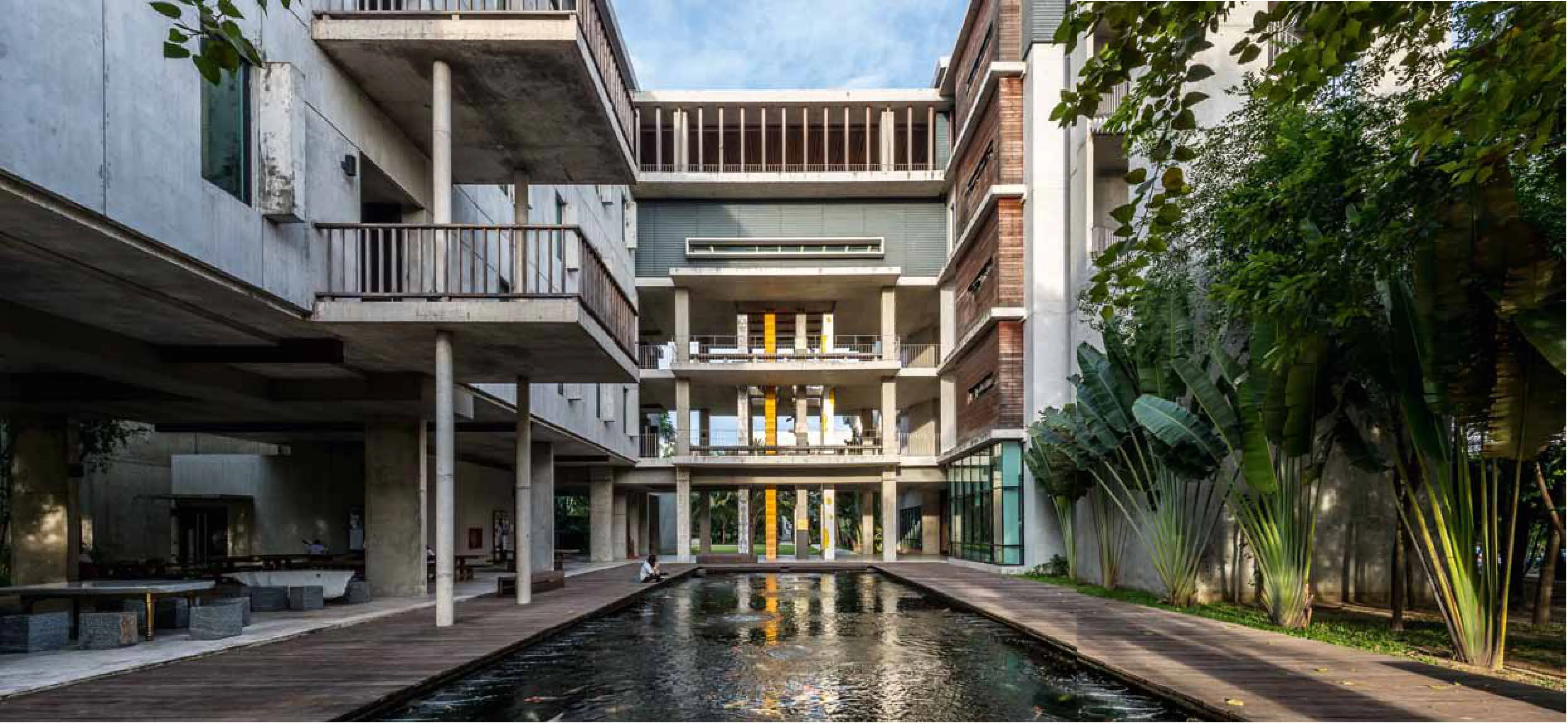
1 艺术家柱廊和水池/Artist poles and pond
作为设计师,我感到言辞穷尽,很难找到合适的语言来解释和表达自己的设计作品所具备的特性。这类表述也许只能提及整个作品的一小部分而忽略了设计中最重要的方面。这种难以捉摸的重要性存在于外部和内部之间,或是实体和抽象之间。如果表述是必要的,我只能谈谈在项目设计过程中面临的挑战和成功克服的限制因素。然而,对建筑来讲,建成的作品应该是不言自明的。
这个项目最具挑战性的方面就是所有功能需求都要安排在封闭空间内:教室、练习室、表演室、录音室等等。比如,噪声控制对教学至关重要,因此门必须始终保持关闭。这种内在的限制因素对建筑装饰带来严格的制约。在这些条件下,需要解决的问题是“我们如何为一个音乐学习社区创造出有活力的、能激发灵感的设施?”
我作品的核心理念可以称之为“核心空间”或是“半室外空间”。假如我们将封闭空间视为“黑”,而将开敞空间视为“白”,那么,设计的焦点就成了在两者之间进行调和,并创造“灰”空间。灰空间元素产生了延续性和联系性。这种效果将带来一种感受上的二元性:封闭的和开敞的、肯定的和否定的,等等。这是一种外部和内部的交流。这种联系源于通过建筑技术发展出点、线、面的集合体并共创和谐。设计与周边自然环境相融合:微风、阳光、雨露给这个设想的灰空间披上了自然的外衣。在建筑中,这一“概念空间”持续不停地前后流动,在某种意义上,模糊了室外与室内的界线。
这个项目的亮点是礼堂。礼堂设计的每一个方面都包含了复杂的技术。困难在于音乐厅的建造需要满足很多条件要求,比如,通过吸音板实现声音回响的控制、专业人员的控制台、音乐厅要能够举办所有种类的音乐表演:声乐、流行摇滚、爵士、泰国古典音乐和交响乐。为了达成这个目标,需要通过墙面和吊顶的帘幕系统调整降低残响时间的数值。□(王靖 译)
项目信息/Credits and Data
客户/Client: 玛希隆大学音乐学院/College of Music, Mahidol University
场地面积/Site Area: 32000m2
建筑面积/Floor Area: 30479m2
设计时间/Design Period: 1997
摄影/Photos: Srirath Somsawat
As a designer, I feel foolish as I struggle to find the right words to explain and communicate the qualities of what I have designed. Such explanations may only cover a small portion of the entire work and miss what is most important in the design. This elusive significance exists somewhere between the external and the internal, or the concrete and the abstract. If an explanation were necessary, I would only talk about the challenges encountered and limitations successfully overcome during the project. However, for architecture, the finished work should be self-explanatory.
The most challenging aspect of this project was that all required functions had to be in enclosed spaces: classrooms, practice rooms, performance rooms, recording studios, etc. For example, sound suppression is very critical to music study, so doors must remain shut at all times. This kind of restriction imposes strict limitations on architectural embellishments. With these conditions in mind, the question is "How do we create a lively, stimulating facility for a music learning community?"
Now, the central concept for my work is what is known as "Key Space" or "Semi-Outdoor Space". If we interpret an enclosed space as "black" and an open space as “white”, the focus here is to incorporate the flows between them, creating "grey" area. The effect will bring a sense of duality: closed and opened, granted and denied etc. It is an interchange of the exterior and the interior. This connectivity is created by applying architectural techniques of developing a matrix of points, lines, and planes that spell their concord. The design allows the blend of surrounding nature: breeze, sunshine, and rain, coat this visionary grey space. In architecture, this "conceptual space" is continually flows back and forth, blurring the border between the exterior and interior.
The highlight of this project is an Auditorium. Every aspect of the design for the Auditorium is combined with complicated technical requirements. The difficult task is to create the Concert Hall with requirements such as the control of sound echo with absorption panels, the station for specialist to operate, the hall’s ability to accommodate all types of musical performances: acoustic, pop rock, jazz, Thai classical, and a full band of orchestra. To accomplish this, the value of RT 60 needs to be adjusted downward by a system of curtains which hang from both walls and ceilings. □
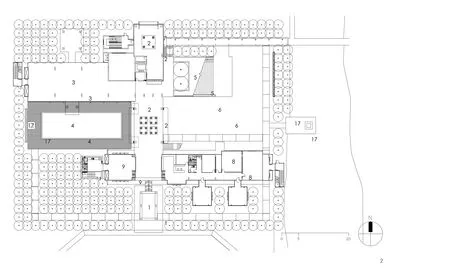
2 首层平面/Floor 0 plan

3 二层平面/Floor 1 plan
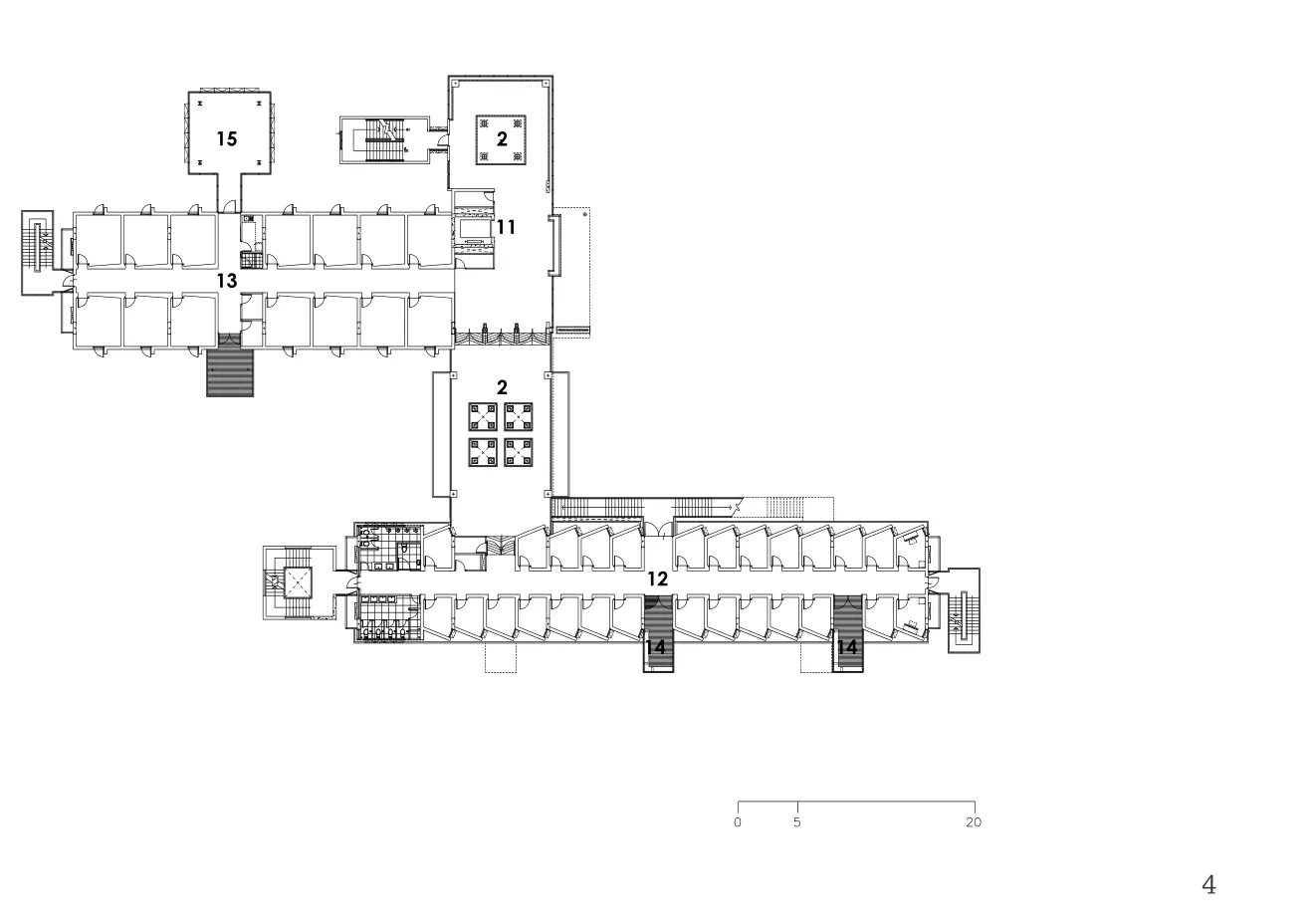
4 三层平面/Floor 2 plan
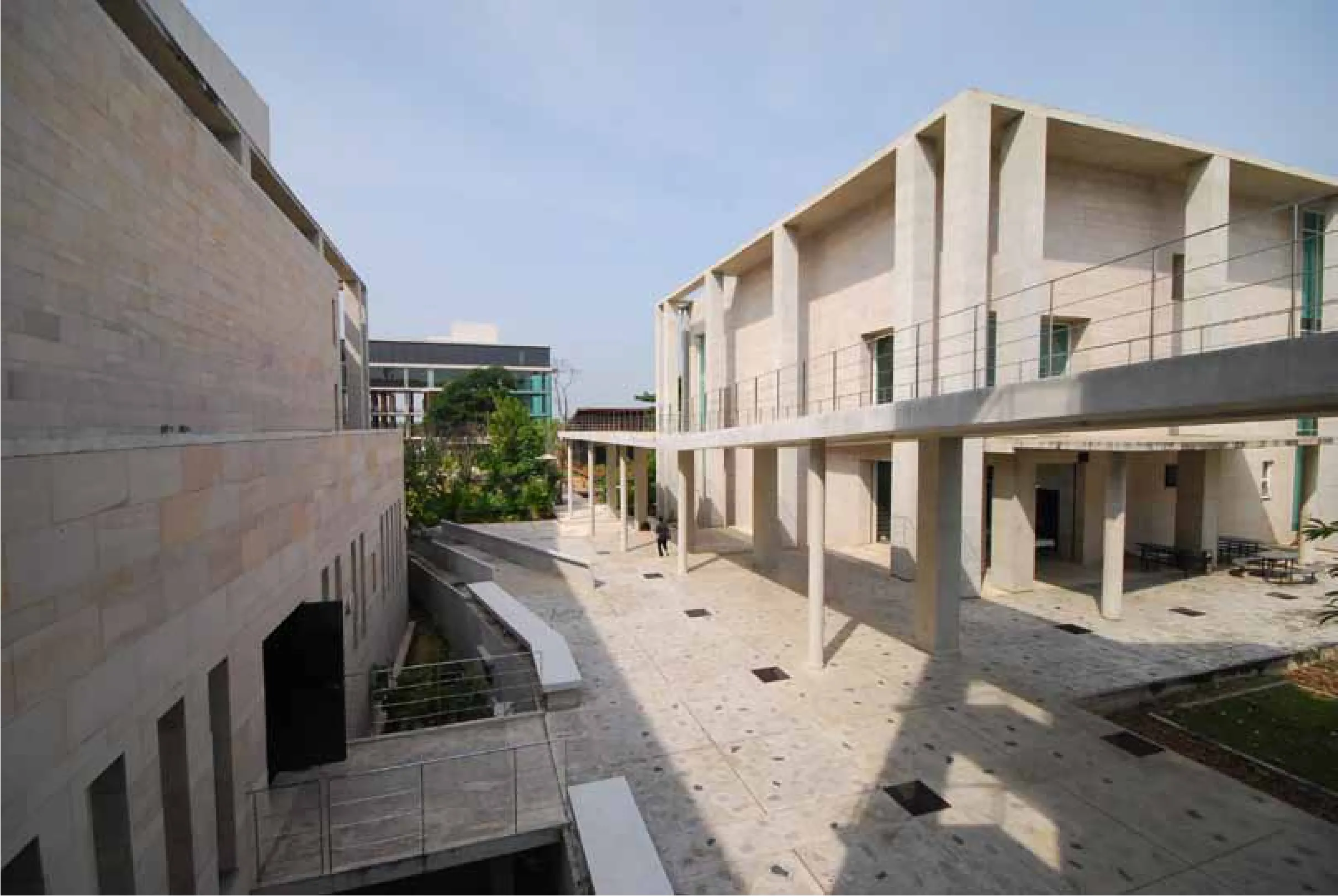
5 去往西区的转换空间/Transfer space to west area of campus

6 四层平面/Floor 3 plan

7 五层平面/Floor 4 plan
1-入口/Entrance
2-艺术家柱廊/Artist poles
3-多功能空间/Multipurpose space
4-水池/Pond
5-阶梯教室/Amphitheather
6-绿化/Green
7-廊道/Covered way
8-音乐治疗室/Music therapy room
9-办公室/Office
10-机房/Mechanical room
11-电梯间/Lift lobby
12-练习室/Practice rooms
13-教学工作室/Teaching studios
14-露台/Terrace
15-教室休息室/Teacher's lounge
16-音乐教室/Music class rooms
17-雕塑/Sculpture

8 从一层走廊看大楼/View from the corridor on the ground floor of Bhumibol Sangkeet Building
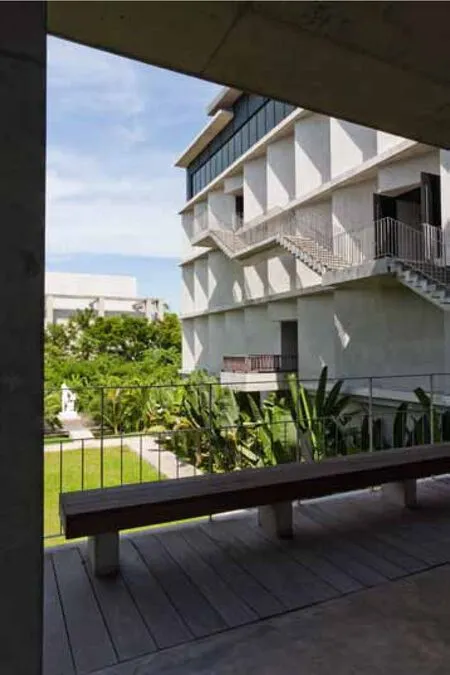
9 从二层走廊看大楼/View from the corridor on the 1stfloor of Bhumibol Sangkeet building
评论
王彦:唤醒身体感官的灰空间
功能布局严谨实用,并无夸张之处。空间氛围也是琐碎而亲切的,并不强调某种纪念性。然而,各种尺度的灰空间着实让人充满遐想,时而是高挑的屋檐,时而是亲切的外廊,时而是一方出挑深远的阳台,而最让人神往的是几乎全架空的底层空间。因为自己也曾有过音乐创作经历,深知回归自然现实对于音乐工作者身心健康的重要性。可以想象,音乐家们从封闭的琴房,完全的精神世界中走出来,在剧烈的感官情绪调动之后,回到亲切平静的半室外空间里,泥土的潮湿气味、暖暖的微风、平静的水面将逐步唤醒各种身体的感官,让人自然地回归到亲切而琐碎的现实世界中。
祁斌:整个项目似乎经历了很长时间的设计和建造过程,使得建筑群体展现出不同的面孔效果,各部分设计语言、材料运用有着十分明显的差别,以致于在建筑之间产生了某种时间错位的感觉。项目的设计逻辑有些让人捉摸不透,建筑的意义似乎存在于建筑特定使用空间外部和内部形态的复杂性表达上,呈现出或具体或抽象,或交流或封闭,或接受或拒绝的一系列双重、多重、不确定的感觉。

10 大楼东翼的灰空间/Grey space at east wing of Bhumibol Sangkeet building
Comments
WANG Yan: Grey Space for Awakening Body Senses
The layout is strict and practical, nothing flashy. Instead of emphasizing monumentality, the space here is tender and focused on detail. But what it has in abundance are all kinds and scales of grey spacesspaces full of reverie in the eaves, warm verandas, on balconies and the so very attractive elevated ground floor space. From my own experiences with music, I understand how important it is for a musician to return to nature and its realities. Imagine this: Musicians leaving sealed practice rooms-complete spiritual worlds of their own-return to these warm calm semi-open spaces with a strong sense of excitement. The smells of damp earth, warm breeze and tranquil water awaken all the body's senses slowly, and naturally lead them to embrace the warm and "trivial" real world.
QI Bin: The project looks complex and disjointed. It seems to have experienced an overly long design and construction process. The clearly differences in architectural language and material between each of the buildings seems haphazard and has the aura of someone working against the clock. The design logics of the project are confusing and unpredictable. The intention of the architecture seems to be to express the complexity of the external and internal morphologywhether literal or abstract, communicating or isolated, accepting or rejecting. It certainly creates a host of uncertain feelings.
Bhumibol Sangkeet Building, Mahidol University, Nakhon Pathom, Thailand, 2013
Architects: Tonsilp Studio
